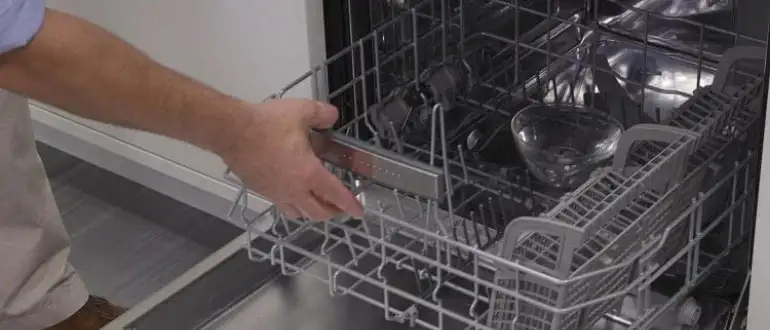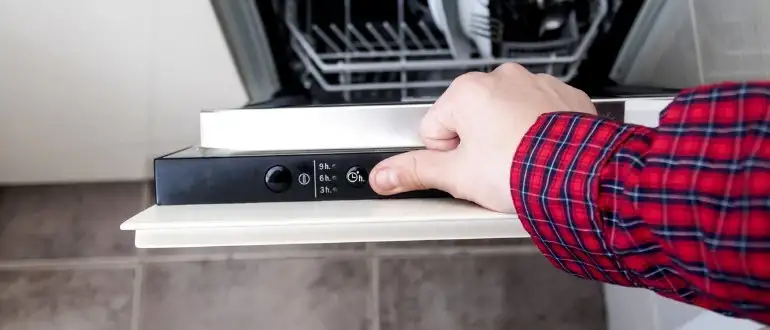The irritating pile of mold in your dishwasher is a common problem. Here you may ask, “ why is there mold in my dishwasher?
Frequent accumulation of mold can hamper the dishwasher’s activity as well as harm your health. So, you must detect the cause of spreading mold to get rid of it.
This article is here to answer your question and guide you to solve the problem regarding mold.
Why Is There Mold in My Dishwasher?
To be accurate, the wet and shadowy environment of your dishwasher causes the mold to build up. Mold or fungus only need a few basic things to live and grow. They are heat, moisture, organic material, and darkness.

The dishwasher is a dark, hot, and damp place that is almost ideal for mold to grow.
Mold is most likely to grow in places that stay wet, such as cracks, and on rubber parts, door seals, gaskets, and drain covers.
The leftover food in your dishwasher and the fact that it is damp, dark, and wet make it a great place for these unwanted molds to live.
How to Identify If Your Dishwasher Has Mold Spores
First, you need to figure out if there is mold in your dishwasher or if it just has a lot of gunk in it.
Mold can be dangerous, so if you think you see mold, wear gloves and goggles. Look for stains and slimy stuff left behind. You might also smell something musty.
If food scraps are left in the dishwasher for a few days, mold will start to grow on them, and you’ll be able to see it.
You may also see that dirt has built up in corners or along with rubber gaskets.
Carefully take out any parts that can be taken out of the inside of your dishwasher and look closely at them for signs of mold.
There will probably be some buildup on the dishwasher filter, but this doesn’t always mold, it could just be dirt.
If the housing around the filter is black or smells musty, however, you can assume that there is mold on it as well.
If you’re not sure what to do, it’s always best to be safe. You can always call in an expert to help you figure out what’s going on.
To avoid health problems, it’s important to find and clean a moldy dishwasher as soon as possible.
How To Get Rid Of Mold In Dishwasher?

Clean and disinfect the gasket
Mold and bacteria like to congregate in the rubber seal that is located on the inside of the door, so you should make it a habit to give it a thorough cleaning once every couple of weeks.
It is possible to remove the bulk of the filth with nothing more than a toothbrush, some soapy water, and some elbow grease; however, adding some white vinegar to the water can assist boost the level of sanitation achieved.
If you don’t fully dry it off with a paper towel after you’re through, the germs will just start gathering all over again.
Clean out debris from the filter
Regular inspection of the filter of the dishwasher for food particles and other debris should be done.
Decomposition of food is a significant contributor to the growth of mold in the dishwasher, particularly if it is moved around the washtub as the cycle progresses.
If you want to prevent mold from growing, you should clean the filter about once a week and scrub the filter fixture with soap and water at least once a month. This will help to keep mold from taking hold.
Clean and dry your dishwasher

If you choose to let your dishes dry naturally after a wash cycle, you could save money on energy costs and help the environment.
However, if you go with the dry option, you will need to ensure that your dishwasher is getting completely dry in between washes.
Keep the door to the dishwasher open while the dishes are air-drying, and perhaps even thereafter if there is still moisture visible in the tub.
Use baking soda and white vinegar for the final rinse
These useful household cleaners are exactly what you need to eliminate mold and mildew in the dishwasher.
They are safe to use near food, making them ideal for usage around dishes, and they are mild enough to ensure that they will not damage the equipment or sensors included within the device.
The heat sensors in your dishwasher are vulnerable to damage from bleach and other strong chemicals, which is something you absolutely do not want to happen.
Spraying the interior of the dishwasher with a solution consisting of vinegar, baking soda, and water can prevent mold from growing and will keep the appliance smelling fresh and clean.
Operate a hot wash cycle

Start a hot wash cycle with nothing more than a bowl of vinegar placed on the upper rack of the dishwasher and some baking soda sprinkled on the bottom of the machine.
You may even want to remove the racks from your dishwasher and wash them separately to get rid of any debris that has caked on or any water scale that may have built up.
Mold will have little chance of growing in your dishwasher if you give it a comprehensive cleaning at least once a month.
Scrub the leftover mold
Even though the vinegar and baking soda will kill any mold that is on the walls, the nooks and crannies of the dishwasher, such as the door seal and the folding arms, may require a little bit more attention.
Scrub any mold that you find with the toothbrush that has been dipped in soapy water.
It is important to pay close attention to the drain as well as the spray arm that is located at the bottom of the dishwasher.
Mold can easily thrive in these environments because moisture and food can congregate there. Scrub each one meticulously.
How To Prevent Mold From Growing In My Dishwasher?

- Clean your dishwasher very well at least once a month
- When cleaning, pay special attention to the rubber parts and the seal around the edge of the dishwasher, as these are prime places for mold to grow.
- Keep your dishwasher door slightly open when you’re not using it to let air in and keep the inside surfaces dry.
- Control the humidity in your kitchen.
- If your sink has a garbage disposal, make sure to run it and clear it out before turning on your dishwasher.
Can dishwasher mold get me sick?
Yes. It poses health risks to you and your family producing many symptoms.
- Mold sensitivity can cause nasal stuffiness, throat or eye irritation, coughing, wheezing, or skin irritation.
- Mold-related infections are more common in young children, the elderly, and those with impaired immune systems.
- It can cause lung infections in immunocompromised and chronic lung disease patients. As are antibiotic users and diabetics.
If anyone in your household falls into one of these higher-risk groups, take extra care to prevent mold growth. If you’re sensitive to mold, keep it out of your dishwasher.
Final Thoughts
We hope that you have got the answer to your question, “ why there is mold in my dishwasher?” mold is a regular occurrence but you can minimize them if maintain proper cleanliness.
Follow the instruction for detecting and killing mold we have described above. It will pave the way of the healthy cleaning of your dishes.

